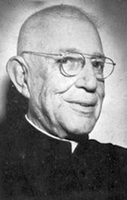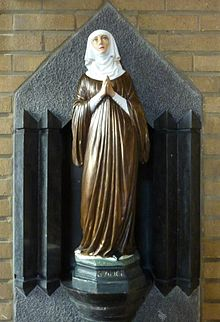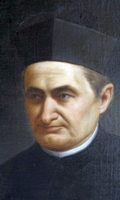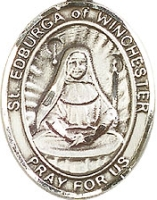John Francis Regis
தூய யோவான் பிரான்சிஸ் ரெஜிஸ்
பிறப்பு: 1597 ஜனவரி 31
பிரான்ஸ்,
இறப்பு: 1640 டிசம்பர் 30
ஏற்கும் சமயம்:
ரோமன் கத்தோலிக்க திருச்சபை
நினைவுத் திருநாள்: ஜூன் 16
இன்று நாம் நினைவுகூரும் யோவான் பிரான்சிஸ் ரெஜிஸ் 1597 ஆம் ஆண்டு ஜனவரி திங்கள் 31 ஆம் நாள், பிரான்ஸ் நாட்டில் இருந்த ஒரு வசதியான குடும்பத்தில் பிறந்தார். இவர் தன்னுடைய தொடக்கக் கல்வியை தனது சொந்த ஊரிலே கற்றார். அதன்பின் இவர் தன்னுடைய மேற்படிப்பை இயேசு சபைத் துறவிகள் நடத்தி வந்த கல்லூரியில் கற்றார். அப்போது அங்கே இருந்த துறவிகளுடைய வாழ்க்கையால் தொடப்பட்டு, தானும் ஒரு துறவியாக மாறவேண்டும் என்னும் ஆசைகொண்டார் இவர். ஆசை கொண்டதும் மட்டுமல்லாமல் 1631 ஆம் ஆண்டு குருவாகவும் அருட்பொழிவு செய்யப்பட்டார்.
யோவான் பிரான்சிஸ் ரெஜிஸ் குருவாக மாறிய பின்பு ஆண்டவரின் நற்செய்தியை மக்களுக்கு எடுத்துரைத்து, ஆன்மாக்களை அறுவடை செய்யும் பணியில் மிக மும்முரமாக ஈடுபட்டார். மிகச் சிறந்த மறைபோதகராக விளங்கிய இவர், தன்னுடைய போதிக்கும் திறமையால் பலரையும் கிறிஸ்துவுக்குள் கொண்டு வந்து சேர்த்தார்.
இதற்கிடையில் இவர் இருந்த தூலூஸ் நகரில் பிளேக் நோய் பரவத் தொடங்கியது. இந்த நோய் பரவி பலரது உயிரையும் எடுத்துக்கொண்டது. இந்தச் சூழ்நிலையில் யோவான் பிரான்சிஸ் ரெஜிஸ் மிகச் சிறப்பான முறையில் பணிகளைச் செய்து, நோயால் பாதிக்கப்பட்ட மக்களுக்கு உதவி புரிந்து வந்தார். இவர் நோயாளிகள்மீது அதிகமான அக்கறை எடுத்துக்கொண்டு அவர்களுக்குப் பணிசெய்து வந்தார். நோயாளிகள் மட்டுமல்லாது கைவிடப்பட்டோர், விபச்சாரத் தொழிலில் ஈடுபட்டு வந்தோர் மறுவாழ்வு பெறுவதற்காகவும் பாடுபட்டார். அவர்களுக்காக விடுதி ஒன்றைக் கட்டி எழுப்பி, அதில் அவர்களை அமர வைத்து, அதன்மூலம் அவர்களுக்குச் சேவைகள் புரிந்து வந்தார்.
இதன்பிறகு இவர் விவியர்ஸ் நகர் சென்று, அங்கு நற்செய்தியை அறிவிக்கத் தொடங்கினார். இவர் ஆற்றிய நற்செய்திப் பணியினால் பலரும் கிறிஸ்தவ மதத்தைத் தழுவினார்கள். இப்படி பல்வேறு பணிகளைச் செய்து வந்த யோவான் பிரான்சிஸ் ரெஜிஸ் நிமோனியாக் காய்ச்சலால் பாதிக்கப்பட்டார். அந்த நோய் இவரைக் கடுமையாகத் தாக்கவே இவர் தன்னுடைய 43 ஆம் வயதில் அதாவது 1640 ஆம் ஆண்டு, டிசம்பர் 30 ஆம் நாள், இறையடி சேர்ந்தார். இவருக்கு 1737 ஆம் ஆண்டு புனிதர் பட்டம் கொடுக்கப்பட்டது.
Saint Francis Regis, SJ Preaching. Michel Ange Houasse. Beginning of the 18th-century. Museo del Prado. Madrid. Spain.
Jesuit missionary, priest, saint
Born 31 January 1597
Fontcouverte, Aude, France
Died 31 December 1640 (aged 43)
Lalouvesc, Ardèche, France
Venerated in Catholic Church
Beatified 18 May 1716, Rome, Papal States by Pope Clement XI
Canonized 5 April 1737, Rome, Papal States by Pope Clement XII
Major shrine Lalouvesc, France
Feast 16 June
Patronage Regis University; Regis High School (New York City); Regis Jesuit High School (Aurora, Colorado); lacemakers
Jean-François Régis, commonly known as Saint John Francis Regis and Saint Regis, (31 January 1597 – 31 December 1640), was a French priest of the Society of Jesus, recognized as a saint by the Roman Catholic Church in 1737. A tireless preacher, Regis is best known for his work with at-risk women and orphans.
Life
Jean-François Régis was born 31 January 1597, in Fontcouverte, Aude, in the Languedoc region of southern France. His father, Jean Régis, had recently been ennobled as a result of service rendered during the Wars of the League. His mother, Marguerite de Cugunhan, was of a noble family.[1] He was educated at the Jesuit College of Béziers. On 8 December 1616, in his nineteenth year, he entered the Jesuit novitiate at Toulouse and he took his vows two years later.[2]
After finishing his course in rhetoric at Cahors, Regis was sent to teach grammar at several colleges: Billom (1619–22), Puy-en-Velay (1625–27), and Auch (1627–28). While he was teaching, he also pursued his studies in philosophy at the scholasticate at Tournon. Noted for an intense love of preaching and teaching the Faith, as well as the desire to save souls,[1] Regis began his study of theology at Toulouse in 1628. Less than two years later, in 1630, he was ordained a priest at 31. The following year, having completed his studies, Regis made his tertianship.[3]
Regis was now fully prepared for his lifework and entered upon his apostolic career in the summer of 1631. He was a tireless worker who spent most of his life serving the marginalized.[4] As a newly ordained priest, he worked with bubonic plague victims in Toulouse. From May 1632 until September 1634, his headquarters was at the Jesuit College of Montpellier. Here he labored for the conversion of the Huguenots, visited hospitals, assisted the needy, withdrew from vice wayward women and girls, and preached Catholic doctrine with tireless zeal to children and the poor.[5] Regis is best known for his work with at-risk women and orphans. He established safe houses and found jobs for them.[4] Regis established the Confraternity of the Blessed Sacrament, which organized charitable collections of money and food from the wealthy. He also established several hostels for prostitutes, and helped many become trained lace makers, which provided them with a stable income and an opportunity to avoid the threat of exploitation.[4]
In 1633, Regis went to the Diocese of Viviers at the invitation of the local bishop, Monsignor Louis II de la Baume de Suze, giving missions throughout the diocese.[3] From 1633 to 1640 he evangelized more than fifty districts in le Vivarais, le Forez, and le Velay.[1] Regis labored diligently on behalf of both priests and laypersons. His preaching style was said to have been simple and direct. He appealed to the uneducated peasantry and numerous conversions resulted.[3]
Regis's labors reaped a harvest of conversions. However, his boldness – perceived as arrogance in some cases – led to a conflict with certain other priests, a period of tension with the local bishop, and even threats of violence from those whose vices he condemned.[6] Although he longed to devote himself to the conversion of the indigenous inhabitants of Canada,[7] he remained in France all his life.
Regis walked from town to town, in rough mountainous areas where travel was difficult, especially in the winter.[4] He died of pneumonia at age forty-three on 31 December 1640,[8] at Lalouvesc (Ardèche), in France's Dauphiné region.
Veneration
John Francis Regis was beatified by Pope Clement XI on 18 May 1716,[6] and canonized by Pope Clement XII on 5 April 1737.
Patronage
John Francis Regis is the patron saint of lacemakers, medical social workers, and illegitimate children.[9]
Saint Benno of Meissen
மெய்ஸ்ஸன் நகர் புனிதர் பென்னோ
ஒப்புரவாளர் மற்றும் மெய்ஸ்ஸன் மறைமாவட்ட ஆயர்:
பிறப்பு: கி.பி. 1010
ஹில்ட்ஷெய்ம், ஸாக்சனி
இறப்பு: ஜூன் 16, 1106
மெய்ஸ்ஸன்
ஏற்கும் சமயம்:
ரோமன் கத்தோலிக்க திருச்சபை
புனிதர் பட்டம்: மே 31, 1523
திருத்தந்தை ஆறாவது அட்ரியான்
பாதுகாவல்: மீனவர்/ நெசவாளர்
நினைவுத் திருநாள்: ஜூன் 16
“ஹில்ட்ஷெய்ம்” நகரின் வசதி வாய்ப்புள்ள பிரபுக்கள் குடும்பத்தின் வாரிசாகப் பிறந்த புனிதர் பென்னோ’வின் வாழ்க்கை வரலாறு பற்றின தகவல்கள் சிறிதளவே உள்ளன. உள்ளூரிலுள்ள புனிதர் மைக்கேல் துறவு மடத்தில் கல்வி கற்ற இவர், கோஸ்லர் அத்தியாய நியாயஸ்தராக இருந்தார். இவர், கி.பி. 1066ம் ஆண்டு, அரசன் நான்காம் ஹென்றியால் மெய்ஸ்ஸன்” நகரின் ஆயரவை அதிகாரமுள்ளவராக நியமிக்கப்பட்டார்.
கி.பி. 1073ம் ஆண்டு, பென்னோ சாக்ஸன் நகர கலகத்தின் ஆதரவாளராக தோன்றினார். இருப்பினும், “லம்பெர்ட்” எனும் வரலாற்றாசிரியரும் சமகால அதிகாரிகளும் தங்கள் பங்குக்கு அவர்மீது மேலும் சிறிதளவு சாட்டினார்கள். அரசன் நான்காம் ஹென்றி கி.பி. 1075ம் ஆண்டு, பென்னோவை நாடு கடத்தினான். ஆனால் மறு வருடமே அவரை திரும்பி வர அனுமதித்தான்.
பட்டம் மற்றும் பதவியளிக்கும் கடுமையான சர்ச்சைகளில் பென்னோ திருத்தந்தை ஏழாம் கிரகோரிக்கு ஆதரவளித்தார். மேலும், கி.பி. 1077ம் ஆண்டு, அரசனுக்கு எதிரான “ரூடோல்ஃப்” என்பவரது தேர்தலில் பங்கெடுத்ததாக கூறப்பட்டது.
எதிர் திருத்தந்தை மூன்றாம் கிளமென்ட்’டுக்கு எதிரானவர் என்ற காரணத்தால் “ரவென்னா” உயர்மறை மாவட்ட பேராயர் “கில்பர்ட்” அவர்களுக்கு ஆதரவளித்தார். இதற்கு அரசன் நான்காம் ஹென்றியும் ஆதரவளித்தான்.
தமது செல்வாக்கினை “சாக்ஸன்” மக்களின் அமைதிக்காக உபயோகிப்பதாக பென்னோ வெளிப்படியாக வாக்குறுதியளித்திருந்தார். ஆனால் அதை அவரால் நிறைவேற்ற இயலாமல் போனது. 1097ல் திருத்தந்தையர் விருந்திற்கு வந்து திரும்புகையில் “இரண்டாம் அர்பன்” அவர்களை சரியான திருத்தந்தையாக அடையாளம் கண்டார். இத்துடன் அவர் நம்பத்தகுந்த வரலாற்றிலிருந்து மறைந்து போனார். ஆயினும் தமது மறை மாவட்டத்திற்கு அதிக சேவையாற்றியிருந்தார்.
அதன்பின்னர் அவரது மறைப்பணிகளைப்பற்றியோ திருச்சபையை கட்டி எழுப்புவதற்கான ஆர்வம் பற்றியோ யாதொரு ஆதாரங்களும் கிடைக்கவில்லை. கி.பி. 1106ம் ஆண்டு, ஜூன் மாதம், 16ம் நாளன்று, பென்னோ இயற்கையாக மரணம் எய்தினார்.
Also known as
Benedict
Profile
Born to the Saxon nobility, the son of Blessed Bezela of Goda; as an adult he was heavily involved in the power politics of his day. Educated in the abbey of Saint Michael, Hildesheim, Germany. Priest. Canon at the imperial chapel at Gozlar, Hanover. Chaplain to Emperor Henry III. Bishop of Meissen in 1066. Participated in the synod of Forcheim, Germany in 1078.
He spent a year in prison for backing the nobility and Pope Saint Gregory VII against Emperor Henry IV over lay investiture and the control of the Church by the State. At one point he was summoned to Rome, Italy; he ordered the canons to lock the cathedral while he was gone in case emperor Henry tried to occupy it. Henry did, and threw the keys of the cathedral into the river as a symbol to show no one could lock the church against him. When Benno returned, he went to the river and found the key; legend says it was protected by a fish.
Following the death of Pope Gregory VII, Benno pledged his allegiance to the anti-pope Guibert, but in 1097 he returned to support of the lawful Pope Urban II.
Even with all the polical involvement and turmoil, Benno never lost sight of his calling as a diocesan bishop. He visited parishes, preached and conducted Mass, enforced discipline among his clergy, and fought simony any place he found it. He was an accomplished musician, supported music and chant in the churches and monasteries, and wrote on the Gospels. In his later years he served a missionary to the Wends.
Benno continued to be an involved and controversial figure in politics even after his death. His biographer, Jerome Emser, worked a lot of Church versus State material into the book. Martin Luther wrote a furious diatriabe against Benno's canonization.
Born
1010 at Hildesheim, Germany
Died
• 16 June 1106 of natural causes
• buried in the cathedral of Meissen, Germany
• when the cathedral was rebuilt in 1285, his relics were translated to the new structure, with many miraculous cures accompanying the move
• relics translated to the bishop's castle at Stolp when Saxony became Protestant
• relics translated to Munich, Germany in 1580
Canonized
1523 by Pope Adrian VI
Patronage
• anglers, fishermen
• weavers
• diocese of Dresden-Meissen, Germany
• Munich, Germany
Saint Lutgardis
Also known as
• Lutgardis of the Sacred Heart
• Lutgardis of Tongres
• Lutgardis of Aywieres
• Ludgard, Ludgardis, Luitgard, Lutgard, Lutgarde, Lutgart, Luthgard, Lutgarda
Profile
A pretty girl with a fondness for clothes and no apparent religious vocation, Lutgardis was sent to the Black Benedictine convent near Saint Trond at age 12 because her dowry had been lost in a failed business venture, and there was thus little chance for a life as a normal, married lay woman. In her late teens Lutgardis received a vision of Christ showing her His wounds, and in 1194 at age 20 she became a Benedictine nun with a true vocation. She had visions of Christ while in prayer, experienced ecstacies, levitated, and dripped blood from forehead and hair when enraptured by the Passion. Chosen as prioress of her community in 1205, she repeatedly refused to be abbess.
The Benedictine order was not strict enough for Lutgardis, and on the advice of her friend Saint Christina the Astonishing, in 1208 she joined the Cistercians at Aywieres (near Brussels in modern Belgium) where she lived for her remaining 30 years. She displayed the gifts of healing, prophecy, spiritual wisdom, and was an inspired teacher on the Gospels. Blind for the last eleven years of her life, she treated the affliction as a gift - it reduced the distraction of the outside world. In one of her last visions, Christ told her when she was to die; she spent the time remaining in prayer for the conversion of sinners.
Born
1182 at Tongres, Limburg, Belgium
Died
• 16 June 1246 at Aywieres (modern Awirs), Belgium of natural causes, just as night office began on the Saturday night following Feast of the Holy Trinity
• relics transferred to Ittre, Belgium on 4 December 1796 to avoid destruction in the French Revolution
Patronage
• birth, childbirth
• blind people, againts blindness
• disabled, handicapped of physically challenged people
• Belgium
• Flanders, Belgium
Representation
• woman with Christ showing her His wounded side
• blind Cistercian abbess
• Cistercian nun being blinded by the Heart of Jesus
• Cistercian to whom Christ extends his hand from the cross
• woman in attendance when Christ shows his Heart to the Father
Saint Cyriacus of Iconium
Also known as
Cyr, Cyricus, Quiriac, Quiricus
Profile
Son of Saint Julitta. When Cyriacus was a small child, his mother was sentenced to death at Tarsus during the persecutions of Diocletian. Cyriacus made a childish attack on Alexander, the sentencing magistrate, and announced that he was a Christian like his mother. The angry magistrate threw the child to the ground, smashing his skull and killing him instantly.
Some scholars claim that the entire story is fiction, and there is no question that earlier writers hugely embellished this popular and frequently retold story.
Blessed Charlemagne dreamed he was saved from death by a wild boar during a hunt by the appearance of a child who promised to save if Charlemagne would clothe him. The bishop of Nevers explained that the child was Cyriacus, and that he wanted the emperor to repair the roof of Saint Cyr's cathedral. This led to the Cyriacus' representation as a naked child riding a wild boar.
Born
c.301
Died
• c.304 at Tarsus by having his skull crushed
• relics enshrined at Nevers, France, and in the monastery of Saint-Amand in Tournai, France
Patronage
• against death of children
• torture victims
Representation
• child being thrown to the ground or down a set of steps by a judge
• child thrown to the ground with a fountain springing from his blood
• holding Saint Julitta by the hand
• naked child sitting a wild boar
Martyrs of Làng Cóc
Profile
A group of five Christian laymen, four farmers and a doctor, from the same village in the apostolic vicariate of Central Tonkin (in modern Vietnam). During the persecutions of emperor Tu Duc, they were each ordered to stomp on a cross to show their contempt for Christianity; they each refused. Imprisoned, tortured and martyred.
• Anrê Tuong
• Ðaminh Nguyen
• Ðaminh Nguyen Ðuc Mao
• Ðaminh Nhi
• Vinh Son Tuong
Born
in Ngoc Cuc, Nam Ðinh, Vietnam
Died
beheaded on 16 June 1862 in Làng Cóc, Nam Ðinh, Vietnam
Canonized
19 June 1988 by Pope John Paul II
Saint Julitta of Iconium
Also known as
Juliot
Profile
Mother of Saint Cyriacus of Iconium. Widow. Moved from Iconium to Isauria to avoid persecution as a Christian. Tortured and martyred during the persecutions of Diocletian. Legend says that from the site of her burial there erupted a miraculous spring of water that cured the sick and improved the health of those who immersed in it.
Some scholars claim that the entire story is fiction, and there is no question that earlier writers hugely embellished this popular and frequently retold story.
Died
• c.304
• sources describe several methods, all horridly painful
Patronage
• against death of children
• single laywomen
• torture victims
• widows
Representation
• burned at the stake
• holding a cross and palm
• holding Saint Cyricus by the hand
• martyred, with a fountain springing from her blood
• standing near oxen
Blessed Donizetti Tavares de Lima
Profile
One of nine boys born to Tristão and Francisca Cândida Tavares de Lima; his father was a lawyer, his mother a professor. Ordained a priest in the diocese of São João da Boa Vista, Brazil in 1908. Serving as a parish priest, he became known as a miracle worker and healer. In 1955, in obedience to his bishop, Father Donizetti limited himself to normal parish work and never spoke of miracles again.
Born
3 January 1882 in Cássia, Brazil
Died
at 11.15am on 16 June 1961 in at the parish hall in Tambaú, Brazil of natural causes
Beatified
• 23 November 2019 by Pope Francis
• the beatification recognition was celebrated at the Church of São José, Tambaú, Brazil with Cardinal Giovanni Angelo Becciu as the chief celebrant
Saint Aurelian of Arles
Also known as
Aurelian the Sinner
Profile
Bishop of Arles, Gaul (modern France) in 546. Founded a monastery and convent in Arles, and brought many relics to them including a piece of the True Cross. The Rule he gave each of the houses in his diocese stressed devotion to the saints and martyrs. Assisted at the Council of Orleans in 549. Referred to himself as Aurelian the Sinner. Papal vicar of Gaul under Pope Vigilius, from whom he received the pallium, one of the symbols of his high office.
Died
• 16 June 551 at Lyon, Gaul (modern France) of natural causes
• entombed at the chapel of Saint Nizier in Lyons
Saint Tycho of Amathus
Also known as
• Tycho of Amato
• Tycho of Amatante
• Tycho of Limassol
• Tychon, Ticon
Profile
Son of a poor baker. First bishop of Amathus (modern Limassol), Cyprus in the early 5th-century. Fought to rid Cyprus of its remaining pagan culture, idols and worship, particularly that related to Aphrodiate. Saint Joseph the Hymnographer composed an Office in his honour. Saint John the Merciful wrote a biography of him.
Died
c.425
Patronage
vine growers (legend says that revitalized a dead vineyard by planting and praying over a single dead leaf)
Blessed Antoine Auriel
Also known as
Constant
Profile
Priest and parochial vicar in the diocese of Cahors, France. Imprisoned on a ship in the harbor of Rochefort, France and left to die during the anti-Catholic persecutions of the French Revolution. One of the Martyrs of the Hulks of Rochefort.
Born
19 April 1764 in Fajolles, Lot, France
Died
16 June 1794 aboard the prison ship Deux-Associés, in Rochefort, Charente-Maritime, France
Beatified
1 October 1995 by Pope John Paul II
Saint Ferrutio and Saint Ferreolus of Besançon
Profile
Brothers. Ferrutio was a priest, Ferreolus a deacon. They were sent by Saint Irenaeus of Lyons to evangelize the area of Besançon, France where they worked for 30 years. Martyrs.
Born
Asia Minor
Died
c.212 in the area of Besançon, France
Martyrs of Africa
Profile
A group of five Christians martyred together. We know nothing else but the names – Cyriacus, Diogenes, Marcia, Mica, Valeria
Died
unknown location in Africa, date unknown
Saint Aureus of Mainz
Also known as
Aureo
Profile
Brother of Saint Justina of Mainz. Bishop of Mainz, Germany. When the Huns attacked Mainz, Aureus fled briefly into exile, but returned. While celebrating Mass in the cathedral, he, his sister and everyone else there were massacred during the Liturgy of the Eucharist. Martyr.
Died
in the cathedral of Mainz, Germany while celebrating Mass
Representation
• bishop at the altar being murdered by Huns
• with Saint Justina of Mainz
Saint Palerio of Telese
Profile
Bishop of Telese, Italy. Saint Equizio of Telese served as his deacon.
Died
• buried in the church of San Palerio at an unknown point
• grave re-discovered following a vision in 1167
• relics re-discovered in 1712 when the old church was being demolished
• relics enshrined under the high altar of the church of Saint John the Baptist on 5 March 1713
Blessed Thomas Redyng
Also known as
Thomas Reding
Additional Memorial
4 May as one of the Carthusian Martyrs
Profile
Carthusian choir monk of the Charterhouse in London, England. Martyred for refusing to accept King Henry VIII as head of the Church.
Died
starved to death on 16 June 1537 in Newgate Prison, London, England
Beatified
29 December 1886 by Pope Leo XIII
Saint Ismael of Menevia
Also known as
Osmail, Ysfael
Profile
Sixth century son of Budic, prince of Cornouaille, Brittany (in modern France), who was forced into exile at Dyfed, Wales. Budic later returned to Brittany, but his three sons preferred Wales where they all became holy men. Ismael was the spiritual student of Saint Teilo of Llandaff who ordained him bishop of Menevia, Wales. Several churches are dedicated in his honour in Pembrokeshire and Carmarthenshire, Wales.
Saint Justina of Mainz
Profile
Sister of Saint Aureus of Mainz. When the Huns attacked Mainz, Justina fled briefly into exile, but returned. While celebrating Mass in the cathedral, Justina, her brother and everyone else there were massacred during the Liturgy of the Eucharist. Martyr.
Died
martyred in the cathedral of Mainz, Germany while celebrating Mass
Representation
being murdered with Saint Aureus of Mainz
Saint Berthaldus
Also known as
Bertaud, Berthold
Profile
Hermit in the Ardennes region of France. Ordained by Saint Remigius of Rheims. The town of Chaumont grew up around his titular abbey and church in the archdiocese of Rheims, France. Indulgences for pilgrimages to Berhaldus' shrine were granted in 1451 and 1466.
Born
Ireland
Died
• c.540 of natural causes
• miracles reported at his death
Saint Similian of Nantes
Also known as
Sambin, Similiano
Profile
Bishop of Nantes, France. Saint Gregory of Tours testified to his holiness.
Died
310 of natural causes
Saint Graecina of Volterra
Also known as
Gracinea, Graeciniana
Profile
Martyred in the persecutions of Diocletian.
Died
• early 4th century
• relics discovered in the Camaldolese church of Saint Justus and Saint Clement, Volterra, Italy in 1140
Representation
young woman with a dagger
Saint Actinea of Volterra
Profile
Martyred in the persecutions of Diocletian.
Died
• beheaded at Volterra, Etruria, Italy in the early 4th century
• relics discovered in the Camaldolese church of Saint Justus and Saint Clement, Volterra, in 1140
Saint Cettin of Oran
Also known as
Cetagh, Cethach, Cethagh
Profile
Spiritual student of Saint Patrick. Bishop. Helped Patrick evangelize Ireland. His shrine at Orran was a place of pilgrimage for centuries, apparently survived into the 18th century.
Died
5th century of natural causes
Saint Ceccardus of Luni
Also known as
Cichardo, Ceccardo
Profile
Bishop of Luni, Italy. Martyr.
Died
c.860 in Carrara, Italy
Patronage
Carrara, Italy
Blessed Gaspare Burgherre
Profile
Mercedarian friar. A member of the Roman Curia, he resigned his position to work to free Christians enslaved by Muslims. Freed 200 of them in the Andalusia region of Spain.
Died
1497
Saint Colman McRhoi
Profile
Spiritual student of Saint Columba of Iona. Deacon. Helped found the monastery of Reachrain (modern Lambay Island), Dublin, Ireland, and served as its abbot.
Died
6th century of natural causes
Saint Amandus of Beaumont
Also known as
Amand, Amatius, Amantius
Profile
Hermit at Beaumont, archdiocese of Rheims, France.
Born
Scottish
Died
6th century of natural causes
Saint Aitheachan of Colpe
Also known as
• Aitheachan of Inbher Colpthai
• Athcain
Profile
Sixth century. While listed in multiple martyrologies, no details about him have surived.
Saint Maurus of San Felice
Profile
Sixth-century bishop. Pilgrim to Rome, Italy. Settle in the village of San Felice near Narni, Italy.
Born
Palestine
Saint Felix of San Felice
Profile
Sixth-century bishop. Pilgrim to Rome, Italy. Settled in the village of San Felice near Narni, Italy.
Born
Palestine
Saint Curig of Llanbadarn
Profile
Bishop of Llanbadarn, Wales. Several Welsh churches are dedicated to him.
Born
Welsh
Died
6th century
Saint Cunigunde of Rapperswil
Profile
Companion of Saint Ursula. Martyr.
Died
Rapperswil, Switzerland
Saint Crescentius of Antioch
Profile
Martyr.
Died
Antioch, date unknown
Saint Elidan
Also known as
Ilid
Profile
Nun in Llangurig, Denbigshire, Wales.
Also celebrated but no entry yet
• Ilpidius of Brioude
• Limbania
• Maria Teresa Scherer
• William of Monferrato











































